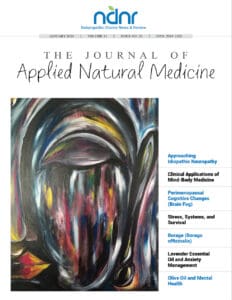Number One Killer
Esther Perreault, ND
 Cardiovascular disease (CVD) is by far the number one killer of Americans,1 and while the risk factors contributing to the development of CVD have been studied extensively, there is much we have yet to discover about this complex set of disease conditions. Insufficient screening, ineffective patient management, and inappropriate treatment strategies are contributing to CVD mortality. Despite this, many of the disease-promoting issues commonly addressed by naturopathic medicine (eg, food sensitivities, adrenal function, diet, and lifestyle modification) can have an important role in the treatment of CVD and its risk factors. Our comprehensive approach combined with more sensitive predictive assessment tools (and integrative medication intervention when appropriate) can dramatically improve the preventive potential for our patients.
Cardiovascular disease (CVD) is by far the number one killer of Americans,1 and while the risk factors contributing to the development of CVD have been studied extensively, there is much we have yet to discover about this complex set of disease conditions. Insufficient screening, ineffective patient management, and inappropriate treatment strategies are contributing to CVD mortality. Despite this, many of the disease-promoting issues commonly addressed by naturopathic medicine (eg, food sensitivities, adrenal function, diet, and lifestyle modification) can have an important role in the treatment of CVD and its risk factors. Our comprehensive approach combined with more sensitive predictive assessment tools (and integrative medication intervention when appropriate) can dramatically improve the preventive potential for our patients.
The Grim Reality
Data from 2007 shows that 33.6% of all deaths were due to CVD.1 That is approximately 1 of every 3 deaths in this country, 1 death every 39 seconds. One of every 6 deaths is due to coronary heart disease specifically. One coronary event occurs every 25 seconds and 1 death due to a coronary event every minute. One stroke occurs every 40 seconds. One of every 9 death certificates mentions heart failure.1 This is the grim reality showing us that the common medical interventions for CVD are clearly insufficient.
Among the risk factors for CVD, type 2 diabetes mellitus ranks among the most significant, along with hypertension, obesity, tobacco use, and high cholesterol level. Eight percent of Americans in 2008 were classified as having diabetes, with another 36.8% having prediabetes (abnormal fasting blood glucose levels).1 Data from the American Diabetes Association2 indicates that 11% of this population will likely develop diabetes each year.
While diet and lifestyle modification are the first-choice recommendations for those newly diagnosed as having many of these cardiovascular risk factors,3 these often do not result in decreased risk. Among patients with hypertension, approximately 70% to 80% report modifying their diet, lifestyle, or both,4 yet 70% fail to achieve adequate blood pressure control.5 If initial improvements are achieved, maintenance of these better health habits is often not sustained.6 If no appreciable improvement is made within 3 months, pharmacologic management of blood pressure and blood glucose and cholesterol levels seems an inevitability for most Americans.
If improvement in CVD risk factors occurs with pharmaceutical intervention, the lifestyle modification approach is often abandoned, and few patients receive further education or are encouraged to safely work to terminate their medication regimens. While some of these medications can save lives (eg, hypertension medications), indiscriminate long-term use (especially at high dosages) without addressing the cause of the problem is not good medicine.
Regardless of whether it is true or false that cholesterol level has a role in CVD risk, statin medications are often prescribed to lower cholesterol level, possibly doing more harm than good. Greater evidence has emerged that statin medications seem to increase the risk of developing type 2 diabetes,7 especially at higher dosages,8 and may decrease the function of the myocardium.9 The effectiveness of statin medications has also been questioned among the diabetic population,10 who have a 2- to 4-fold increased likelihood of developing CVD.2 Additional cardiovascular medications like b-blockers and diuretics may raise the risk of developing type 2 diabetes.11 Given the close relationship between diabetes and CVD, such interventions do not bode well to avoid development or worsening of CVD, although more data is necessary to determine long-term effects.
Comprehensive and Multifactorial Approach for the Long Term
Clearly, diet and lifestyle modification are much better options for decreasing heart disease risk in the long term,12 but getting patients to follow the recommendations can be challenging. Patient compliance is significantly affected by what recommendations are being made, how that information is relayed, and when follow-up contact is scheduled.
A small study13 out of England found that increasing the frequency of follow-up care had a significant influence on patient motivation, and compliance increased when instructions were delivered by physicians instead of nurses. A summary statement from the American Heart Association14 recommended increased frequency of follow-up visits and highlighted additional strategies that have been documented to improve patient compliance with behavioral modification. These strategies include the following: setting goals, self-monitoring, maintaining frequent and sustained contact, obtaining feedback from the healthcare provider, modeling good behaviors, problem solving, preventing relapse, and motivational counseling.
In promoting the adoption and maintenance of lifestyle modification to prevent and treat CVD, it is the art of medicine rather than the science that is lacking. The comprehensive and multifactorial approach of naturopathic practice seems an ideal context in which to optimize patient compliance. We cannot rely solely on the development of an effective dietary, botanical, or supplement regimen. If a meaningful reduction in CVD mortality is to occur, efforts must be made to facilitate the long-term adoption of dietary and lifestyle changes, including various mind-body techniques (eg, emotional freedom technique, biofeedback, and neurofeedback) and activities like hypnosis, counseling, and group support.
Naturopathic attention to tolle causam requires us to address contributing factors that are often overlooked. As a general ND, with a significant portion of my patients presenting with CVD or its risk factors, I often see marked food sensitivities contributing to hypertension. Many other patients have the “deficient hypertension” tendency of nutrient deficiencies (especially magnesium, coenzyme Q10, etc), poor digestion and absorption, “adrenal fatigue,” dehydration, disrupted sleep patterns, and poor stress management skills. While diet and lifestyle interventions seem the obvious choice for long-term CVD prevention and management, there may be a place for medication management (in some individuals and under certain conditions), making an integrative approach appropriate. Our naturopathic goals at that point must include optimizing organ function to decrease the required medication dosage if possible and to protect the patient from adverse effects and long-term complications.
While effective treatment of CVD and associated risk factors is necessary, improved surveillance and detection of disease in the asymptomatic patient is of obvious importance. More advanced screening tools for the asymptomatic patient with 1 or more risk factors are becoming available. Coronary artery calcium scoring may be an option for those with intermediate CVD risk, especially when additional motivation to make lifestyle changes is necessary and if computed tomographic radiation exposure does not represent undue risk for the patient.15,16 An alternative screening tool that does not involve radiation exposure but seems less sensitive than coronary artery calcium scoring is brachial-ankle pulse wave velocity, which has been suggested for inclusion in community health screenings.17
If we can figure out a way to routinely, effectively, and efficiently screen our patients and implement meaningful treatment strategies that are designed to achieve long-term success, the incidence of CVD would be dramatically decreased. While the first choice in treatment is often diet and lifestyle modification, few of us are able to effectively support and guide our patients through the steps necessary to achieve long-term improvement. Using the entirety of our naturopathic training, the holistic approach (including mind-body intervention) seems to offer the most promise in addressing the CVD epidemic, although an integrative approach is often in the patient’s best interest and must be considered.
 Esther Perreault, ND is a licensed ND (New Hampshire) and an adjunct professor of nutrition, practicing in Westminster, Massachusetts. She also lectures extensively, having authored numerous lectures, programs, and seminars on various health topics, and works with employee and corporate wellness programs throughout New England. She practices with an emphasis on cardiovascular disease, digestive problems, autoimmune conditions, anxiety, menopause, thyroid and other hormone issues, weight management, nutrition, wellness, and preventive care. Dr Perreault believes that working with the body and focusing on the root cause of disease, while educating and empowering patients to take control of their own health, encompass the power of naturopathic medicine.
Esther Perreault, ND is a licensed ND (New Hampshire) and an adjunct professor of nutrition, practicing in Westminster, Massachusetts. She also lectures extensively, having authored numerous lectures, programs, and seminars on various health topics, and works with employee and corporate wellness programs throughout New England. She practices with an emphasis on cardiovascular disease, digestive problems, autoimmune conditions, anxiety, menopause, thyroid and other hormone issues, weight management, nutrition, wellness, and preventive care. Dr Perreault believes that working with the body and focusing on the root cause of disease, while educating and empowering patients to take control of their own health, encompass the power of naturopathic medicine.
References
1. Roger VL, Go AS, Lloyd-Jones DM, et al; American Heart Association Statistics Committee and Stroke Statistics Subcommittee. Heart disease and stroke statistics: 2011 update: a report from the American Heart Association [published correction appears in Circulation. 2011;123(6):e240]. Circulation. 2011;123:e18-e209. http://circ.ahajournals.org/content/123/4/e18.long. Accessed August 12, 2011.
2. American Diabetes Association. Home page. http://www.diabetes.org. Accessed August 11, 2011.
3. Smith SC Jr, Blair SN, Bonow RO, et al. AHA/ACC Guidelines for Preventing Heart Attack and Death in Patients With Atherosclerotic Cardiovascular Disease: 2001 update: a statement for healthcare professionals from the American Heart Association and the American College of Cardiology. J Am Coll Cardiol. 2001;38(5):1581-1583.
4. Centers for Disease Control and Prevention (CDC). Prevalence of actions to control high blood pressure: 20 states, 2005. MMWR Morb Mortal Wkly Rep. 2007;56(17):420-423.
5. Hajjar I, Kotchen TA. Trends in prevalence, awareness, treatment, and control of hypertension in the United States, 1988-2000. JAMA. 2003;290:199-206.
6. Rothman A, Sheeeran P, Wood W. Reflective and automatic processes in the initiation and maintenance of dietary change. Ann Behav Med. 2009;38(suppl 1):S4-S17.
7. Sattar N, Preiss D, Murray HM, et al. Statins and risk of incident diabetes: a collaborative meta-analysis of randomised statin trials. Lancet. 2010;375(9716):735-742.
8. Preiss D, Seshasai SR, Welsh P, et al. Risk of incident diabetes with intensive-dose compared with moderate-dose statin therapy: a meta-analysis. JAMA. 2011;305(24):2556-2564.
9. Rubinstein J, Aloka F, Abela GS. Statin therapy decreases myocardial function as evaluated via strain imaging. Clin Cardiol. 2009;32(12):684-689.
10. Leiter LA, Lundman P, da Silva PM, Drexel H, Jünger C, Gitt AK; DYSIS Investigators. Persistent lipid abnormalities in statin-treated patients with diabetes mellitus in Europe and Canada: results of the Dyslipidaemia International Study [published online ahead of print June 16, 2011].
11. Elliott WJ,Meyer PM. Incident diabetes in clinical trials of antihypertensive drugs: a network meta-analysis. Lancet. 2007;369(9557):201-207.
12. Ford ES, Bergmann MM, Kroger J, Schienkiewitz A, Weikert C, Boeing H. Healthy living is the best revenge. Arch Intern Med. 2009;169(15):1355-1362.
13. Roberts A, Roberts P. Intensive cardiovascular risk factor intervention in a rural practice: a glimmer of hope? Br J Gen Practice. 1998;48:967-970.
14. Artinian NT, Fletcher GF, Mozaffarian D; American Heart Association Prevention Committee of the Council on Cardiovascular Nursing. Interventions to promote physical activity and dietary lifestyle changes for cardiovascular risk factor reduction in adults: a scientific statement from the American Heart Association. Circulation. 2010;122(4):406-441.
15. Silber S, Richartz BM. Evidence-based application of cardiac magnetic resonance and cardiac computed tomography for primary diagnosis of stable coronary artery disease with special attention to disease management programs and the German National Medical Care Guidelines. Herz. 2007;32(2):139-158.
16. Budoff M, Gul K. Expert review on coronary calcium. Vasc Health Risk Manage. 2008:4(2):315-324.
17. Liu CS, Li CI, Shih CM, et al. Arterial stiffness measured as pulse wave velocity is highly correlated with coronary atherosclerosis in asymptomatic patients [published online ahead of print April 6, 2011]. J Atheroscler Thromb. doi:10.5551/jat.7021. Medline:21467807.

